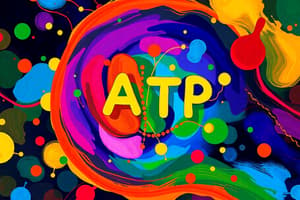Podcast
Questions and Answers
What is the primary function of ATP in living cells?
What is the primary function of ATP in living cells?
- To facilitate the controlled release of energy in enzyme-catalysed metabolic pathways
- To serve as the 'energy currency' of living cells, providing energy for various cellular activities (correct)
- To store energy for long-term use
- To act as a precursor molecule for the synthesis of other nucleotides
Which of the following statements is true about anabolic pathways?
Which of the following statements is true about anabolic pathways?
- They are typically exergonic, releasing energy in the form of ATP
- They are only found in prokaryotic cells
- They are involved in the synthesis of molecules, often requiring energy input (correct)
- They involve the breakdown of molecules to release energy
What is the role of NADH in energy metabolism?
What is the role of NADH in energy metabolism?
- It is a byproduct of glycolysis, with no significant role in energy metabolism
- It serves as an energy storage molecule, releasing energy as needed
- It acts as an electron acceptor in the electron transport chain
- It is a carrier molecule, transferring electrons to other molecules (correct)
What is the primary function of coenzyme A in energy metabolism?
What is the primary function of coenzyme A in energy metabolism?
In eukaryotic cells, where is the β-oxidation pathway typically located?
In eukaryotic cells, where is the β-oxidation pathway typically located?
What is the term for the controlled release of energy in enzyme-catalysed metabolic pathways?
What is the term for the controlled release of energy in enzyme-catalysed metabolic pathways?
What is the common characteristic of the names of catabolic pathways?
What is the common characteristic of the names of catabolic pathways?
Where does the generation of ATP and NADH occur?
Where does the generation of ATP and NADH occur?
What is the purpose of stepwise breakdown in metabolic pathways?
What is the purpose of stepwise breakdown in metabolic pathways?
How can metabolic pathways be regulated?
How can metabolic pathways be regulated?
What is the consequence of activating enzyme 1 and enzyme 2 in a pathway?
What is the consequence of activating enzyme 1 and enzyme 2 in a pathway?
Where is energy released at each step in metabolic pathways stored?
Where is energy released at each step in metabolic pathways stored?
What is the significance of ATP in metabolic pathways?
What is the significance of ATP in metabolic pathways?
What is the characteristic of ATP that makes it a suitable energy currency?
What is the characteristic of ATP that makes it a suitable energy currency?
What is the primary function of ATP in metabolic control?
What is the primary function of ATP in metabolic control?
What is the energy available from the hydrolysis of ATP to ADP?
What is the energy available from the hydrolysis of ATP to ADP?
What is the role of UTP in biosynthetic reactions?
What is the role of UTP in biosynthetic reactions?
What is the result of transferring two H atoms to NAD+ from a donor?
What is the result of transferring two H atoms to NAD+ from a donor?
What makes the hydrolysis of ATP energetically favourable?
What makes the hydrolysis of ATP energetically favourable?
What is the composition of a hydrogen atom?
What is the composition of a hydrogen atom?
What is the role of Na+/K+ pumps in the cell?
What is the role of Na+/K+ pumps in the cell?
What is the reaction that occurs when glucose is converted to glucose-6-phosphate?
What is the reaction that occurs when glucose is converted to glucose-6-phosphate?
What is the function of NAD+ in metabolic reactions?
What is the function of NAD+ in metabolic reactions?
What is the result of transferring one H atom to NAD+ from a donor?
What is the result of transferring one H atom to NAD+ from a donor?
What is the primary function of ATP in biochemical reactions?
What is the primary function of ATP in biochemical reactions?
What is the term for a 'high energy' bond that links the acetyl group to Coenzyme A?
What is the term for a 'high energy' bond that links the acetyl group to Coenzyme A?
What is the primary location of catabolic reactions in a cell?
What is the primary location of catabolic reactions in a cell?
What is the term for a metal ion that is required for an enzyme's activity?
What is the term for a metal ion that is required for an enzyme's activity?
What is the correct definition of catabolism?
What is the correct definition of catabolism?
What is the primary function of enzymes in biochemical reactions?
What is the primary function of enzymes in biochemical reactions?
What is the term for a molecule that is required for an enzyme's activity, but is not a part of the enzyme itself?
What is the term for a molecule that is required for an enzyme's activity, but is not a part of the enzyme itself?
What is the primary function of coenzyme A in biochemical reactions?
What is the primary function of coenzyme A in biochemical reactions?
What is the role of the liver in the context of amino acid metabolism?
What is the role of the liver in the context of amino acid metabolism?
What is the result of the transamination reaction between an amino acid and α-ketoglutarate?
What is the result of the transamination reaction between an amino acid and α-ketoglutarate?
What is the role of glutamine in the context of amino acid metabolism?
What is the role of glutamine in the context of amino acid metabolism?
What is the byproduct of the deamination reaction of glutamine?
What is the byproduct of the deamination reaction of glutamine?
What is the term used to describe the remaining carbon skeleton after the removal of an amino group from an amino acid?
What is the term used to describe the remaining carbon skeleton after the removal of an amino group from an amino acid?
What is the reaction that involves the conversion of glutamine to glutamate and α-ketoglutarate?
What is the reaction that involves the conversion of glutamine to glutamate and α-ketoglutarate?
Flashcards are hidden until you start studying
Study Notes
Introduction to Metabolism
- Metabolism: the sum of all chemical reactions in the body
- Anabolism: synthesis of complex molecules from simpler ones, requiring energy
- Catabolism: breakdown of complex molecules into simpler ones, releasing energy
Key Features of Metabolic Pathways
- Catabolic pathways release energy, anabolic pathways require energy
- Pathways can be regulated by controlling specific enzymes
- Stepwise breakdown of molecules releases energy in usable packages
- Different 'forward' and 'reverse' pathways allow separate regulation
Activated Carrier Molecules
- Energy released at each step is stored in activated carrier molecules (e.g. ATP, NADH, FADH2)
- Examples of activated carrier molecules: NAD+/NADH, FAD/FADH2, Coenzyme A/acetyl CoA
Importance of ATP
- ATP is the energy currency of living cells
- ATP is synthesized in catabolic pathways
- ATP is structurally stable at pH 6-9, with specific proteins and enzymes recognizing its features
ATP Hydrolysis
- ATP breakdown releases energy, which is available for cellular work and chemical synthesis
- ATP hydrolysis is energetically favorable due to the high energy of phosphoanhydride bonds
Functions of ATP
- Used in metabolic control, regulating enzyme activity
- Used in metabolism to add Pi to metabolic intermediates
- Other high-energy nucleotide carriers (e.g. UTP, GTP) are used to drive specific biosynthetic reactions
Role of NAD+ and Coenzyme A
- NAD+ is an electron acceptor, transferring 2H atoms
- Acetyl-CoA is a 'high-energy' thioester bond, storing energy from oxidation of glucose and fatty acids
Metabolic Reactions
- Require fuel molecules, enzyme catalysts, and cofactors
- Enzyme cofactors can be coenzymes, activating ions, or prosthetic groups
Summary Diagrams
- Show summary diagrams of metabolic pathways with links to other main metabolic processes
- Cell Biology textbooks show summary diagrams with the cellular location of the main metabolic pathways
Studying That Suits You
Use AI to generate personalized quizzes and flashcards to suit your learning preferences.




